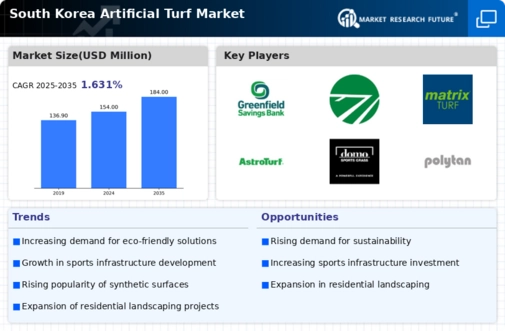Rising Demand for Sports Facilities
The increasing interest in sports and recreational activities in South Korea appears to drive the demand for artificial turf. As more sports facilities, including soccer fields and multi-purpose arenas, are constructed, the artificial turf market experiences growth. According to recent data, the number of sports facilities in South Korea has risen by approximately 15% over the past five years. This trend indicates a growing recognition of the benefits of artificial turf, such as lower maintenance costs and enhanced durability. The artificial turf market is likely to benefit from this rising demand, as facility owners seek to provide high-quality playing surfaces that can withstand heavy use. Furthermore, the government's initiatives to promote sports participation may further bolster the market, creating opportunities for manufacturers and suppliers in the artificial turf market.
Environmental Regulations and Standards
In South Korea, stringent environmental regulations are increasingly influencing the artificial turf market. The government has implemented various standards aimed at reducing environmental impact, which has led to a shift towards eco-friendly materials in artificial turf production. This regulatory landscape appears to encourage manufacturers to innovate and develop sustainable products, potentially increasing their market share. For instance, the use of recycled materials in artificial turf could appeal to environmentally conscious consumers and organizations. The artificial turf market is likely to see a rise in demand for products that comply with these regulations, as stakeholders prioritize sustainability. As a result, companies that adapt to these standards may gain a competitive edge, positioning themselves favorably within the evolving market.
Increased Investment in Urban Green Spaces
The South Korean government's commitment to enhancing urban green spaces is likely to positively impact the artificial turf market. As cities become more densely populated, the need for accessible recreational areas has become paramount. Artificial turf offers a viable solution for creating green spaces in urban environments, where traditional grass may struggle to thrive. Recent initiatives to develop parks and recreational areas using artificial turf indicate a growing trend towards sustainable urban planning. The artificial turf market stands to benefit from these investments, as municipalities and private developers seek durable and low-maintenance options for their projects. This trend may lead to a significant increase in demand for artificial turf, as urban planners recognize its potential to enhance the quality of life in densely populated areas.
Technological Innovations in Product Development
Technological advancements in the production of artificial turf are reshaping the market landscape in South Korea. Innovations such as improved fiber technology and enhanced drainage systems are contributing to the development of high-performance turf products. These advancements not only improve the aesthetic appeal of artificial turf but also enhance its functionality and longevity. The artificial turf market is witnessing a surge in demand for these technologically advanced products, as consumers increasingly seek quality and performance. Market data suggests that the adoption of advanced manufacturing techniques has led to a 20% increase in product durability, making artificial turf a more attractive option for various applications. As technology continues to evolve, the market is likely to experience further growth driven by consumer preferences for innovative solutions.
Growing Popularity of Landscaping and Aesthetic Applications
The rising trend of landscaping and aesthetic enhancements in residential and commercial properties in South Korea is contributing to the growth of the artificial turf market. Homeowners and businesses are increasingly opting for artificial turf due to its low maintenance requirements and year-round visual appeal. This shift in consumer preferences appears to be driven by a desire for attractive outdoor spaces that require minimal upkeep. The artificial turf market is likely to see a surge in demand as landscaping professionals incorporate artificial turf into their designs. Market analysis indicates that the landscaping segment could account for up to 30% of the overall artificial turf market by 2026. As aesthetic applications gain traction, manufacturers may need to adapt their offerings to meet the evolving needs of consumers.






















Leave a Comment